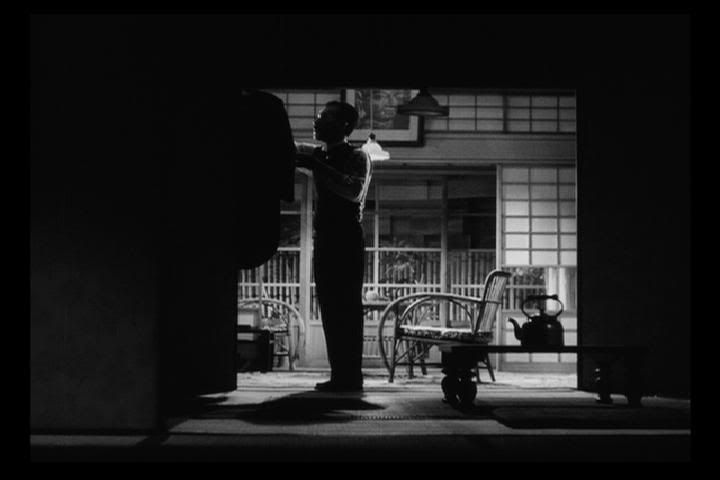
Yasujiro Ozu is a director whose appeal is utterly inexplicable, and yet almost impossible to resist. Whenever I watch one of his quiet, deceptively simple films, I am inevitably mesmerized by the peerless rhythm of his images, the graceful composition of his low-angle, usually static shots, the subtle characterizations and rich emotional subtexts he draws from his talented casts. Late Spring is one of his loveliest, calmest, and most gently affecting works, a meditative examination of familial love and the societal pressures that can damage it. The film's plot is minimal in the extreme, allowing Ozu greater freedom to explore his characters' well-hidden emotions and milieu. The aging widower Somiya (Ozu regular Chishu Ryu) somewhat reluctantly begins planning to marry off his only daughter, Noriko (the dazzling Setsuko Hara, also a regular actor for Ozu), who has taken care of him since his wife died and with whom he has a deep bond. Somiya clearly does not want to part with his daughter, and Noriko is openly antagonistic to the prospect of marriage. Both father and daughter seem content with their lives, largely solitary except for each other and a few friends, and neither really wants the change that Noriko's marriage would bring to their lives and relationship.
Nevertheless, the societal mandate for marriage is strong, and Somiya finally gives in to the pressuring of his sister to find Noriko a potential husband, though Noriko herself resists for much longer. Despite the melodramatic potential of this situation, Ozu keeps the tensions subdued, expressed only in the form of strained glances, forced smiles, and awkward, faltering conversations. All of this is filmed from Ozu's usual low camera position, an intimate set-up which gives him a unique perspective on his characters and their lives. This choice of camera position is often linked to the tatami mats which traditionally served as seats in Japanese homes, and that's probably at least part of its meaning. At the most superficial level, the low camera position does seem exceptionally well-suited to filming seated figures. But there's certainly more to it than that. This camera set-up has the unique quality of being simultaneously intimate, in that it is close to the characters and embedded in their surroundings, and distancing, in that the characters, seen from slightly below rather than head-on, are kept somewhat at arm's length. This is in keeping with Ozu's dispassionate storytelling, which draws us close to his characters but doesn't ever reveal quite what they are thinking or feeling.
We see quite a bit of Noriko throughout this film, in intimate conversations, but her motivations and thoughts remain largely a mystery. We're unsure, for instance, of her true feelings regarding her father's aide, Hattori. Does she love him and regret that he's taken? Does she want only friendship? Is she indifferent? In many respects, with her gentle smile and charming manner, Noriko remains opaque. Her feelings on love and sexuality, though presumably crucial to any discussion of marriage, are never articulated or even addressed. Her relationship with her father is more clear-cut, and bound up with genuine love, devotion, and seemingly a happiness in knowing that she is needed. This is a powerful bond, and whenever father and daughter are on screen together, the pair radiates contentment and familial love.
It's hard to find an Ozu film that is anything short of great, but Late Spring is especially stunning in its effect, certainly among my top few Ozu favorites, and also one of his finest technical achievements, at least before his conversion to color added a whole new set of paints to his palette. The stately, measured pace of the editing is always the most salient stylistic feature for me in Ozu's work, and that seems especially the case here. In the opening few minutes, Ozu cuts between long shots down a hallway, showing women gathering for a supper together, and disconnected shots of exteriors — a pagoda-like building, a grass-covered hill. His editing establishes both a sense of place, and a subtle mood of undefined longing and sadness. The mood in these near-silent opening scenes is enhanced by the quiet murmur of the soundtrack, which mingles Hollywood-style themes with the barest hints of Japanese melodies. This music, almost unbearably sad and affecting, is the film's only melodramatic touch, and its emotional nakedness plays nicely against the comparative restraint of the characters. Ozu's careful editing also comes into play during many of the face-to-face conversations, in which he often employs a rapid series of 180-degree cuts, showing whoever is speaking in turn. This technique is one of the few times in Ozu's work (at least the later films; I haven't seen any silents) when he uses something like a subjective camera, since the effect puts the audience in the place of the listener in the conversation. When contrasted against the generally disengaged camera placement in other scenes, this close-up montage can have a particularly dramatic effect, as it does in the scene when Noriko reminisces about the past with an old classmate.
One of Ozu's finest works, Late Spring is a masterpiece of complex emotions hidden just below the surface. Its power lies in its ultimate ambiguity, the mingling of loss, despair, and hopefulness that wafts through the film and finally comes to a head in its final few scenes. No other director could extract so much depth from such quiet, minimal, uneventful material. Ozu was a true master of his craft, and every film I watch by him fills me with sheer joy.
If you haven't seen any silents, you're in for a treat. See Tokyo Chorus (1931) first, because that was the first in which his characteristic themes and style were manifest. Then see his three silent masterpieces: I Was Born But..., Passing Fancy and A Story of Floating Weeds (all three voted Film of the Year by Japanese critics) and end with his first talkie, the remarkable The Only Son.
ReplyDelete